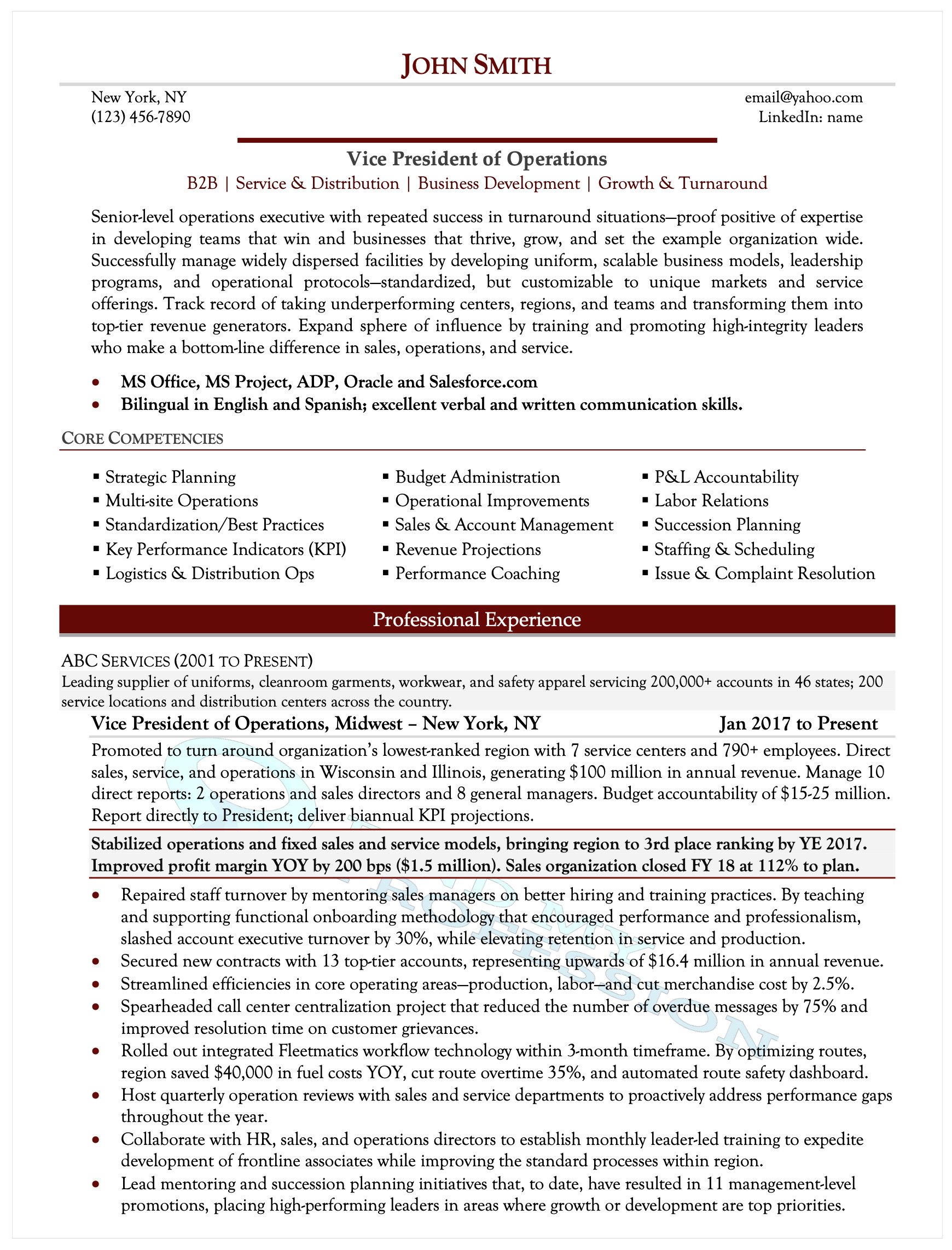Crafting an executive resume is not as easy as it seems. Professional resume writers are paid hundreds and even thousands of dollars to write executive resumes.
If you have some time to learn the skill, and would prefer to save yourself the expense of hiring a professional resume writer, we can teach you everything you need to know.
 Executive resumes are held to a higher standard than most resumes. For that reason, it’s important that you pay close attention. We will outline the 10 most important factors to consider when writing an executive resume.
Executive resumes are held to a higher standard than most resumes. For that reason, it’s important that you pay close attention. We will outline the 10 most important factors to consider when writing an executive resume.
As a special bonus, we’ve also included the top mistakes that executives make on their resume.
How to Write an Executive Resume?
1. Start With a Clear Target in Mind:
As an executive, you are expected to have a clear job target in mind. Applying to jobs with a general resume will do you no good. At the executive-level, a “catch all” approach does not work. You need to be hyper targeted with your resume and focus on a very specific job type.
If you aren’t sure what kind of jobs to apply for, start by seeing what is currently posted online. There are a variety of executive job search sites that you can search from. Type in your desired job title and read a couple job descriptions. For example, if you are currently a Director of Operations, a logical next career move could be a Vice President of Operations role. Search “Vice President of Operations” on your favorite job board and see if they are a good fit.
Once you’ve decided what kind of jobs you are interested in applying for, you can start crafting your resume. Do not start writing your executive resume before having a clear target in mind. Your target job will be the baseline for the resume you are going to write.
2. Find an Executive Resume Template or Design:
The next step when crafting an executive resume is finding a nice template to use. An appealing resume design can make a big difference in the amount of time a recruiter will spend reviewing your resume. The last thing you’d want is to spend hours crafting a great resume only to have it overlooked due to a poor design.
Executive resume templates are typically more conservative than non-executive templates. You will want to avoid designs with a lot of bright colors. You will also want to make sure the template you choose is Applicant Tracking System (ATS) compatible. Templates with images, graphs, charts, and icons are not ATS compatible so make sure to avoid these.
Below we’ve included a sample resume template fit for an executive. You will notice there are no excessive colors or graphics. It’s professional, clean, and easy to read and scan.
3. Add Your Contact Information:
Now that you have a clear target in mind and you have found an amazing resume template, it’s time to start writing the resume. We are going to start from the top of the resume and work our way down.
The very top of your resume should include your name, email, phone number, location, and LinkedIn (optional). You should not list your full address. Listing only the city and state will work fine. If you are going to add your email or LinkedIn profile, make sure to add a hyperlink. This will make it easier for recruiters to contact you.
It’s also recommended that you use your preferred name on your resume. So, if you prefer to be called John, write John on your resume. Do not write Jonathan on your resume unless you prefer to be called Jonathan.
4. Choose a Customizable Executive Headline:
Executive resumes should always have a customizable resume headline. If you look at the sample above, you will see that John Smith’s headline says “Vice President of Operations”. This makes it abundantly clear to any recruiter or hiring manager that John is a relevant applicant for a VP Operations job opening.
This section of your resume should be right under your contact information and right above your professional summary. It’s one of the first things that an executive recruiter or hiring manager will see when scanning your resume. The best part is, this section of your resume can easily be customized for each job you apply to.
If John decided to apply to a Vice President of Supply Chain job, he could simply change that headline to say Vice President of Supply Chain. The headline should always match the job title of the position you are applying for. This will almost always cause the person reviewing your resume to continue reading to learn more about you.
5. Craft a Compelling Executive Summary:
Your resume summary is exactly what it sounds like, a summary. The goal here is to summarize your entire resume into only a few short sentences. A strong summary will grab the reader’s attention by creating interest in your profile. A weak summary can do the exact opposite.
It’s important to note that summaries and objectives are not the same. Objectives, for the most part, are not used anymore. Instead, resumes use summary statements. The purpose of an objective was to tell the reader what kind of position you were hoping to obtain. The purpose of a summary is to summarize your skillsets and explain how you are qualified for this specific job.
Most employers care more about what you can do for them, then what they can do for you. This is why executive summaries have become increasingly more popular than objective statements.
A compelling summary should be highly targeted towards the job you are applying for. If it’s a Vice President of Operations leadership role, you should talk about your leadership abilities, years of experience in Operations leadership positions, relevant experience in their industry, etc. You should not talk about how you are a great salesperson, how you have a finance degree, or how you prefer individual contributor roles.
6. Add Key Skills / Core Competencies:
Every great resume should have a section dedicated towards key skills and core competencies. Typically, this section goes right below the executive summary and right above the work experience. Not only is this section great for recruiters to understand your skills, it’s also an optimal place to add relevant keywords on your resume.
Keywords have never been more important to use on resumes. With new resume screening technologies coming out daily, it’s important that you stay up to date with the latest resume trends. Many recruiters and Applicant Tracking Systems are using keywords to match applicants to positions. If you are using the correct keywords on your resume, you are much more likely to land an interview.
As an executive, it’s ok to have a mixture of hard and soft skills. The soft skills should focus on your overall leadership and management abilities. The hard skills should be highly relevant to the job. These key skills can also be edited for each job you are applying to. If you notice specific skills required on the job description that you have, add them to your resume.
Some common skills for a Vice President of Operations might be:
- Compliance
- Cost Savings
- Customer Service
- Financial Planning & Budgeting
- Logistics
- Process Improvement
- Project Management
- Risk Management
- Strategic Planning
- Team Leadership
7. List Your Past 10 – 15 Years of Professional Experience:
Your work experience is by far one of the most important parts of your resume. A great headline, summary, and key skills will peak a recruiter’s interest enough to want to review your work experience. Now that you have them on the hook, it’s time to close the deal with an amazing work experience section.
Executive resumes tend to be 2-pages long. It’s unlikely that you will be able to fit all of your work experience on 1-page and anything over 2-pages is typically too long. If you are having a hard time getting your resume to fit on 2-pages, there’s a simple trick. Only list the most recent 10 to 15 years of experience on your resume. Most recruiters only care about what you have done recently, and don’t need to see that you started out working in the warehouse 20 years ago.
Your work experience should include a mixture of job duties and accomplishments. We recommend using paragraph style writing for the summary of your job duties and bullet points for your accomplishments. Use the resume sample above as reference.
Here’s a short sample of what your work experience section could look like:
“Recruited to turnaround an underperforming call center with an annual budget of $15M. Responsible for leading a team of two managers and 25 call center agents across multiple states.
- Reduced ticket response time by 30% and increased client satisfaction ratings from 3.4/5 to 4.6/5.”
You’ll notice that the paragraph text above summarizes the job while the bullet point lists a specific accomplishment.
8. Add Your Formal Education & Certifications:
As an executive, it’s common to have received formal education at a university. If you have graduated with a Bachelor’s degree or another advanced degree such as an MBA, or PhD, you will want to include this on your resume. Your education section should always go below your work experience section unless you have graduated in the past two years.
Leave off your GPA if the university you attended was more than 10 years ago. If you recently just graduated and you achieved a 3.5/4 or higher, you can include your GPA. In most cases, it’s best to leave off your high school and focus exclusively on college. It’s ok to include the school you attended for your bachelors as well as any other schools you attended for advanced degrees. Start with your bachelors and work up.
This is also a great section to include any relevant certifications you may have received. If you are a Six Sigma Black Belt, this is definitely worth mentioning on your resume. However, if you earned your Series 7 ten years ago and you are not applying for finance roles, this might not be worth including on your resume. Including irrelevant certifications could confuse hiring managers and make them unsure of the types of jobs you are targeting.
9. Proofread your resume and check for typos:
You’d be surprised how judgmental recruiters and hiring managers can be of typos on your resume. They may feel like you do not have great attention to detail, or you are not professional if you include minor typos on your resume.
To avoid the possibility of any negative thoughts, thoroughly review your resume for typos or formatting issues. Use a grammar tool such as Hemingway or Grammarly to check for typos, run-on sentences, or other formatting issues.
If you have any grammar gurus in your immediate family, ask them to review your resume and focus exclusively on grammar. They should not be commenting on your overall resume, just the grammar. You will want to reach out separately to recruiters and experts in your industry to receive feedback on your resume that goes beyond the grammar.
10. Pressure test your brand-new executive resume:
Before applying to jobs with your new executive resume, it’s important that you pressure test it with experts in your field of work. If you have a few colleagues or old bosses that will review your resume, that’s great. If you don’t have any close connections that you feel comfortable having review your resume, try reaching out to a few strangers on LinkedIn.
You’d be surprised how willing people are to help review a resume. Search LinkedIn for a couple of recruiters in your industry and ask them politely to review your resume. If you are applying for Vice President of Operations jobs at SaaS companies, reach out to a couple of operations executive recruiters who work in SaaS. Try to get feedback from at least 2-3 individuals before using the resume to apply for jobs.
Here’s a sample message you can send someone on LinkedIn:
“Hi Name. I was hoping you could do me a huge favor… I recently updated my resume and was hoping to get feedback from an expert such as yourself. Would you be open to glancing at my resume and providing some quick feedback? No need to spend more than a couple minutes reviewing. I’m interested in your first impressions.”
Wrapping Up:
Resumes are still highly relevant when applying to jobs online. As an executive, you are held to a higher standard than most. While writing an executive resume can seem like a challenge, it’s a one-time investment that can be used for many years.
Make sure to follow these main resume tips:
- Define your target job.
- Find a template you enjoy.
- Customize your headline.
- Summarize your experience.
- List highly relevant skills.
- Summarize job duties and accomplishments.
- Add education and certifications.
- Proofread and pressure test your executive resume.
Once you have a high-quality executive resume, it’s easy to make slight customizations and edits for future jobs. Put in the work now to create a resume that you will be proud of in the future. A top-notch resume could be the difference between you landing the job, or someone else.













































